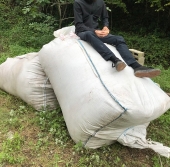Samuel,
So great, your mind is off and running already with this project!! I like that. And a brick edge! Wow! Now that is a serious garden bed.
First off though, do you get enough light under that tree to grow a tomato plant? If so, then great. If not, we can work on that. But at any rate, I will give you my step by step process
1) Since you plan on using bricks, get them started first. Maybe rake any obvious pine needles, pine litter off the surface, but this is not strictly necessary.
2) Lay down a nice thick layer of cardboard. This will serve as a temporary barrier against things that the Wine Caps don't like about pines. It won't last, but hopefully by the time it breaks down, you will have plenty of mushrooms
3) Get some bagged manure or topsoil and sprinkle to a depth of 1-2 inches. This is just to simulate a soil base. It is probably unnecessary, but worth a try
4) Fill up with wood chips! In fact, I would overfill just a bit so that the chips are slightly mounded above the edges. If you get the wine cap spawn growing right, that level will drop significantly
******Additional optional steps detailled below
5) Take the mushroom spawn you bought and mix in to the chips.
******Additional optional step
6) Water down the chips
7) Cover with 2-4 inches or so with straw (grass clippings can work as well
9) Water everything again
10) Hurry up and wait!! This might well take a year!
*******Additional optional steps:
If you want to use the bed to grow some vegetables the first season, you will have to have some growing medium. The easiest is probably bagged topsoil/manure. I use this to dig fertile holes. A fertile hole, in this case, is a hole you will dig in your chips BEFORE you inoculate with spawn. You simply dig a hole about 6"-12" across and deep. Fill in with the bagged soil/manure, and then mark with a stake or a tomato tower or something so you can find it later. Save those chips you dug out for a little bit.
Step 4.1) Dig fertile hole and save chips
Step 4.2) Fill hole with topsoil/manure
Step 4.3) Mark hole with stake or something
Step 5.1) After inoculating, spread extra chips from fertile holes (the ones you saved) and sprinkle over surface, maybe 1-2 inches deep. This is to serve as a evaporation barrier and help maintain moisture in the inoculated chips
Step 11) Plant your tomatoes (or other plants) The tomatoes will
1) Provide dappled shade
2) give roots for the spawn to interact
3) Give you tomatoes!
You could grow potatoes also, or frankly, just about anything that you want to grow! This last summer I poked a bunch of peas in my chips next to summer squash. I had no intent of harvesting peas, I just wanted their shade, roots, and nitrogen they fix
**Updated 4/26/2020 due to important information helpfully provided by Hugo Morvan HERE:
https://permies.com/t/108551/wine-cap-compost-observations#1093304
Step 12) (optional). Place a cardboard layer on top of the chips to help retain and regulate moisture. This can radically speed up the time for the wine caps to spread throughout the wood chips.
But if your area is too shady, I would consider just about any annual plant that would grow in the shade. You could just grow flowers.
I do have a couple of questions for you though
1) do you want this to become a permanent vegetable bed? If so, doing the above steps will get you off to an awesome start! But if you want it to be a vegetable bed, I would aim for 12" of chips as their volume will radically decrease over the years
2) If you just want mushrooms and compost to dig out and haul around to other places, that's fine too. You won't need as many chips, but you won't get as much mushroom compost either. Basically, the more actual compost you want, the deeper you want your chips (though I would not go much higher than about 12" deep)
3) Personally I am a big fan of making the bed a dual purpose bed, growing mushrooms and tomatoes (or whatever) the first year and then each year, getting more and more veggies in the bed.
I hope this helps, and as always, if you have any questions, please do not hesitate to ask.
Eric

 3
3





 4
4




 2
2


















 3
3









 1
1







































 4
4











